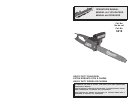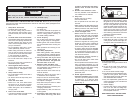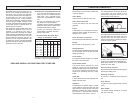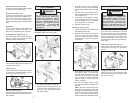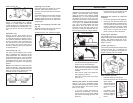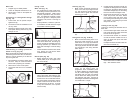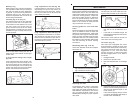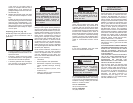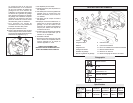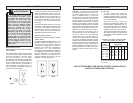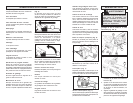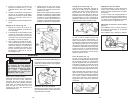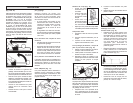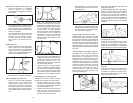
10 11
APPLICATIONS
A
Fig. 12
Chain oil (Fig. 12)
Proper lubrication prolongs chain and guide
bar life. In warm weather use a SAE-30
weight oil. In colder weather use SAE-20
or SAE-10 weight oil. Use only clean oil to
prevent damage to the automatic oiler. Un-
screw the cap (A) and fill oil tank before
use.
Automatic oiler
Catalog number 6215 Chain Saw is
equipped with an automatic oiler. The oiler
is preset at the factory to provide continu-
ous guide bar lubrication while the saw is
running. To check if oiler is working prop-
erly, hold the nose of the chain saw about
4" from the log and run the chain saw. If
the oiler is working properly the log should
be spotted with oil.
Chain brake (Fig. 13)
The chain saw is equipped with a brake
that is actuated by the movement of the
hand guard/brake. The movement of the
hand guard/brake opens a spring loaded
switch that interrupts the power and me-
chanically stops the chain until the hand
guard/brake is returned to the operating
position.
NOTE: Do not attempt to remove the chain
brake from the saw. Using the chain saw
without a chain brake will prohibit the users
ability to stop the chain abruptly and may
increase the risk of personal injury.
B
A
Fig. 14
Fig. 13
Operating
position
Braking
position
Adjusting chain brake
The brake should be checked for normal
operation before each period of use.
Push the hand guard/ brake into the brak-
ing position.
If the brake doesn't stop the chain abruptly
when it is applied, the brake needs
adjusting. Take the saw to an authorized
MILWAUKEE service center for repair and/
or adjustment.
Starting and stopping the chain saw
(Fig. 14)
To start the chain saw, push in the lockout
button (A) and pull the trigger (B).
To stop the chain saw, release the trigger.
Beware of Kickback (Fig. 15 & 16)
"Kickback" is the term used to describe the
sudden, rapid backward and/or upward
motion of the chain and guide bar. Pinch
Kickback (Fig. 15) is the rapid backward
movement of the saw which can occur
when the wood closes in and pinches the
moving saw chain in the cut along the top
of the guide bar. Rotational Kickback
(Fig. 16) is the rapid upward and back-
ward motion of the saw which can occur
when the moving saw chain near the up-
per portion of the tip of the guide bar con-
tacts an object, such as a log or branch.
Fig. 15
If the guide bar and chain are pinched
the saw will tend to be pulled into the
wood and not thrown toward you.
Reducing the chance of rotational
kickback
Do not cut with the tip of the guide bar.
Check the work area and avoid acci-
dentally brushing the tip against wood.
Cut one piece of wood at a time and
check to make sure that while cutting
one piece that the nose doesn't acci-
dently come in contact with another
piece of wood or other obstruction.
Preparing for Kickback
The operator should do everything pos-
sible to reduce the chance of kickback (see
above). The operator should also do ev-
erything possible to be prepared for kick-
back if it occurs.
Correct grip (Fig. 17)
The correct grip will help the operator keep
control of the saw. Fig. 17 shows the cor-
rect grip on the saw with the thumb and
fingers encircling the front handle.
Fig. 17
Fig. 16
Fig. 18
Reducing the chance kickback
Use recommended guide bar and chain,
others may not reduce kickback.
Make sure chain is sharp and properly
lubricated. Dull, improperly sharpened,
and/or unlubricated chains can cause
kickback.
Allow saw to come to full speed be-
fore applying it to the cut.
Keep saw running when removing it
from the cut.
Reducing the chance of pinch kickback
Always try to cut in a downward motion,
with the bottom side of the chain and guide
bar. This will reduce the chance of kick-
back in two ways:
If you are cutting downward on
branches or bucked logs , the cut will
tend to open up as you go and reduce
the chance of pinching the chain and
guide bar.
Body position (Fig. 18)
Plant feet firmly on solid ground.
Hold saw with left arm straight with
elbow locked.
Stand to left side of
cut, out of the kick-
back path of the
saw.
Cut within a com-
fortable controlled
reaching distance
at chest height or
below.
Pinch Kickback
Rotational
Kickback



